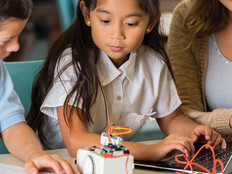ISTE 2012: How Tools Like media:scape Can Improve Collaboration
One challenge when it comes to collaborating during video conferences is that when a participant wants to share something on his or her laptop or mobile device, everyone in the meeting is forced to huddle around a tiny interface or pass a VGA cord back and forth to see what's on the screen. This not only wastes 5, 10, 15 minutes per meeting, it breaks the flow of the collaborative environment. This is made more challenging by the fact that different teams and staff carry different devices -- laptops, tablets, smart phones -- and, in most cases, not just one device, but two or three! When users want to share information, create and collaborate, it can be very frustrating.
While at the International Society for Technology in Education's (ISTE's) annual convention earlier this week, I discovered a solution that seeks to address these issues, media:scape by PolyVision. Introduced at the Consumer Electronics Show (CES) in January, media:scape allows for collaboration across the desk, and the globe, by enabling participants to easily share the content on their digital devices to a single monitor that all meeting participants can see. I sat down with a PolyVision rep for some hands-on time with the media:scape mini, which supports up to four participants. The company's flagship product, called simply, media:scape, supports up to eight participants.
How It Works
Participants open the media-well, a rectangular box about the size of a briefcase, that sits on top of the table. As soon as a participant takes out a "puck" and connects it to his or her laptop or mobile device, the puck begins to glow, indicating it has access to a monitor. Participants then press the puck when they have something to share, whether it's online information, a presentation, or a file from their device and the screen is mirrored on the media:scape monitor for all participants to see. When another participant has something to share, he or she simply presses his or her own puck, and all participants can see their screen, too.
Imagine a grade-level team decides they are going to collaboratively build a lesson. With media:scape, one teacher can look for a video; another can write the lesson objective and gather resources; a third can design a slideshow or Prezi; and a fourth can engage an online personal learning network (PLN) to find examples of projects and rubrics.
Participant #1 touches the puck: "What do you think about this 2-minute video clip...should we use it?"
Participant #2 touches the puck: "Here's the objective so far. Hey, check out this one resource I found. Have you ever seen this guy's blog?"
Participant #3 touches the puck: "Wanna watch the slideshow I just made? Should I add this picture to it or not?"
Participant #4 touches the puck: "A friend I met at ISTE taught this topic last year and here's a product one of her students made and posted online. Do you want our students to make something like this, too? Oh, and here's her rubric. Let's edit this a bit for our students."
It's not that the above statements can't be made without media:scape. And it's not as though thousands of teachers can't work within the limitations of their existing, traditional meeting environments. Most school communities will continue to hobble along, squinting their eyes over a colleague's smartphone, trying to collaborate as efficiently as they can. But when all you have to do is touch a puck to share your screen with the rest of the group, the free flow of ideas and collaborative environment can really flourish.
Make the Technology Transparent
Technology has to get out of its own way. When we interact with a piece of hardware, we aren't thinking about the widget itself -- we're thinking about our content and our ideas. It's not too often a piece of technology comes along that actually makes the technology itself disappear. This puts the focus back where it belongs: on the conversations, ideas and innovations of the participants, and leads to a more collaborative environment. You don't have to be a techie to "get it." It's plug-and-play.
While creation and innovation are the two most valuable commodities a work force offers its organization, administrators often fail to foster and nurture these values in their people. This is an opportunity to help employees, teachers, students and others do what they do best: innovate and create through collaboration.
For more news from ISTE 2012, check out ISTE 2012 hub for articles, videos and more.







